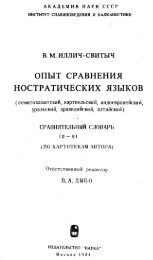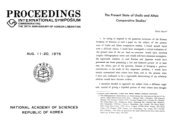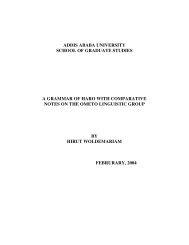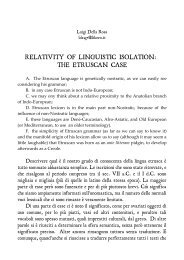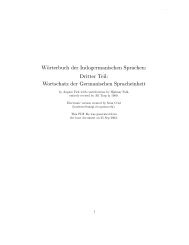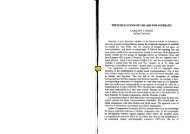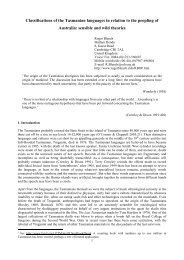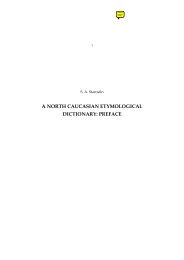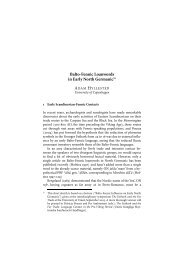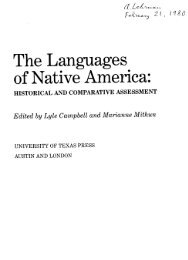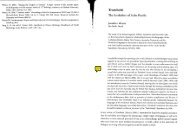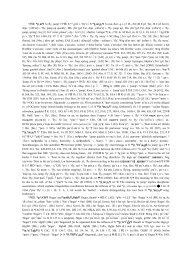The Indo-European Elements in Hurrian
The Indo-European Elements in Hurrian
The Indo-European Elements in Hurrian
You also want an ePaper? Increase the reach of your titles
YUMPU automatically turns print PDFs into web optimized ePapers that Google loves.
9. Before Proto-<strong>Indo</strong>-<strong>European</strong> and <strong>Hurrian</strong> 151<br />
Proto-<strong>Indo</strong>-<strong>European</strong> had a series of syllabic resonants: *i, *‚, *C, *3. In the parallels<br />
that we are uncovered between the vocabularies of <strong>Hurrian</strong> and Proto-<strong>Indo</strong>-<strong>European</strong>, these<br />
sounds are consistently represented <strong>in</strong> <strong>Hurrian</strong> as follows:<br />
Proto-<strong>Indo</strong>-<strong>European</strong> <strong>Hurrian</strong><br />
i um<br />
‚ un<br />
C ul<br />
3 ur<br />
Thus, it appears probable that a series of syllabic resonants is to be reconstructed here as well for<br />
Pre-<strong>Hurrian</strong>/<strong>Indo</strong>-<strong>European</strong>: *i, *‚, *C, *3.<br />
Next, <strong>Hurrian</strong> conta<strong>in</strong>ed a series of dental affricates. Such sounds are miss<strong>in</strong>g from<br />
Proto-<strong>Indo</strong>-<strong>European</strong>. This gap has always been problematic from a typological perspective. In<br />
general, a contrast between velars and labiovelars, such as that posited for Proto-<strong>Indo</strong>-<strong>European</strong>,<br />
implies a frontal contrast of some k<strong>in</strong>d. <strong>The</strong>re are various ways <strong>in</strong> which this frontal contrast can<br />
be realized: (a) palatalized alveolar stops, (b) palato-alveolar affricates, or (c) dental affricates.<br />
In the lexical parallels between <strong>Hurrian</strong> and Proto-<strong>Indo</strong>-<strong>European</strong> that we have uncovered, the<br />
<strong>Hurrian</strong> dental affricates correspond to dental stops <strong>in</strong> Proto-<strong>Indo</strong>-<strong>European</strong>. We assume that<br />
<strong>Hurrian</strong> preserved the orig<strong>in</strong>al situation and that the dental affricates were elim<strong>in</strong>ated <strong>in</strong> Proto-<br />
<strong>Indo</strong>-<strong>European</strong> through deaffricatization and merger of the result<strong>in</strong>g sounds with the traditional<br />
dental stops, thus:<br />
*ˆ > *t (> traditional *t)<br />
*ˆ’ > *t’ (> traditional *d)<br />
*m > *d (> traditional *dh)<br />
(It may be noted that similar changes have taken place <strong>in</strong> Coptic [cf. Loprieno 1995:42—44].) In<br />
<strong>Hurrian</strong>, on the other hand, *ˆ > *ˆ, while *ˆ’ and *m merged <strong>in</strong>to * m.<br />
F<strong>in</strong>ally, there are the laryngeals. In Chapter 2, we posited four laryngeals for Proto-<strong>Indo</strong>-<br />
<strong>European</strong>, without def<strong>in</strong><strong>in</strong>g their phonetic characteristics: *H÷, *Hø, *Hù, and *Hú. Laryngeals<br />
*H÷ and *Hú are not represented <strong>in</strong> the <strong>Hurrian</strong> writ<strong>in</strong>g, while *Hø and *Hù appear as ¯. In<br />
Akkadian, ¯ represents a voiceless velar fricative /x/. <strong>Hurrian</strong> had both voiceless and voiced<br />
velar fricatives, /x/ and /γ/, both of which were written with the signs for ¯.<br />
Thus, it appears the the phonological system that needs to be reconstructed for Pre-<br />
<strong>Hurrian</strong>/<strong>Indo</strong>-<strong>European</strong> is as follows:<br />
Vowels<br />
i u<br />
(e) (o)<br />
a



